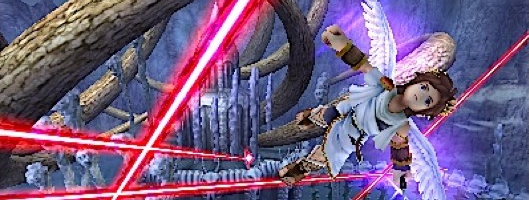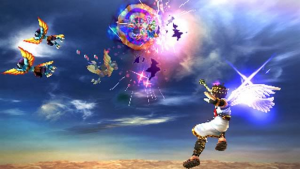When we talk about the voice of Nintendo’s game design the name most commonly mentioned is Shigeru Miyamoto, but a lesser talked about designer who has been doing some interesting things is Masahiro Sakurai. He first worked at Hal Laboratory developing the Kirby series and Smash Bros, along with collaborating on the development of Meteos.
After leaving Hal he formed his own studio: Project Sora to continue working with Nintendo and having the freedom to work on his own projects. One being the recent Smash Brothers Brawl and today’s game – Kid Icarus: Uprising. While not everything clicks with Kid Icarus, there are a lot of interesting mechanics at work.
Divine Intervention:
Kid Icarus: Uprising is considered the very long time coming sequel to the Kid Icarus series, with the last game released in 1991. The plot is that the series’ villain: Medusa is back to threaten the world and it’s up to angel Pit to once again save us from evil.
The story doesn’t take itself seriously at all, which goes with Sakurai’s recent interview where he talked about how he doesn’t like it when the plot gets in the way of gameplay. The game is full of fourth wall breaking conversations, retro styled introductions to some boss fights and the back and forth between Pit and his boss Palutena.
Gameplay is where Kid Icarus: Uprising goes off the beaten track with its mechanics. Every level of the game is made up of two sections: A five minute on rails shooting part and on ground fighting. The story behind it is that Palutena gives Pit the power to fly but it only lasts five minutes before the wings burn away.
Once on the ground, you have direct control over Pit’s movement as you make your way through each stage to reach the boss. Pit can dash that influences his attack, dodge attacks and get in close for sword slashes.
Now, these two sections together would make for a fairly interesting but linear experience, however it’s what Sakurai has added outside of the gameplay that helps elevate Kid Icarus: Uprising.
Before every level you choose what weapon Pit will take with him for both gameplay sections. Weapons come in a variety of types: Swords, cannons, clubs etc that affect general use, attack damage and randomized modifiers as you would see in an ARPG.
The weapon type also plays into Kid Icarus‘s attack system. As some weapons offer a super shot if the player doesn’t attack for a few seconds. And whatever direction Pit dashes will also change his attack if he attacks mid-dash.
As you play, you’ll be rewarded with new weapons from treasure chests whose contents are randomized both for weapon type and attributes. Weapons can be further unlocked by spending hearts (in game currency) at the store or fusing weapons in your inventory to make new ones.
Kid Icarus: Uprising has a risk vs. reward difficulty slider that the player can interact with to get better items. The difficulty setting or “intensity” is ranked on a scale of 0 to 9 with the game set at the start at 2.0. By using hearts the player can raise or lower the scale before a level. The higher the intensity, the stronger and more dangerous enemies become, but at the same time you’ll receive more hearts for killing them and treasure chests and bosses will have better rewards.
In many of the levels there are intensity gates that will reveal alternate paths and better treasures, but require the player to be playing either at or above the marked intensity. This type of player control difficulty system is a good fit with the varied weapons as it gives the game a second system of progression.

Ground combat is where the bulk of the gameplay takes place in and where the controls can get in the way.
As a player you can’t just automatically set the game at max intensity both because you won’t have enough hearts at the start and that you really need to use better weapons to stand a chance.
Instead you have to work your way up to play the game at the harder levels which for expert players, gives them something to look forward to without punishing newer players.
When you throw in special abilities that can be equipped, achievement system and multiplayer, Kid Icarus: Uprising has a lot to offer. Unfortunately there is one problem that comes really close to sinking the game and making it unplayable. And I don’t mean unplayable because the game mechanics don’t work, I mean unplayable as in: Difficult for people who only have two hands.
Control Conundrum:
Kid Icarus: Uprising features one of the hardest control schemes I’ve seen in a handheld game and I played The World Ends With You. There are two major problems with the scheme but to understand them we need to go over the default control setup.
To control Pit, you’ll use the circle pad (located on the left hand side of the system) to move him around and perform dash maneuvers, while pressing the L button to fire. Aiming and moving the camera is done via the touch screen: Dragging the stylus quickly in any direction will swing the camera and tapping the screen will stop the movement.
There are also special abilities that can be cycled through and activated by using the D-pad which can be very hard to hit while fighting enemies.
Moving the stylus normally will control the targeting reticule, however the reticule will not adjust itself in relation to the stylus position. This means that the player has to keep adjusting their hand position to match the reticule to be able to aim during combat.
The first major problem is that this setup is entirely unfriendly to left handed people (like yours truly.) Most of the time, you want to use your dominant hand when performing the more important actions. In Kid Icarus: Uprising‘s case that would be aiming and adjusting the camera. However you literally can’t do that as there would be no way for you to use your right hand to manipulate the circle pad at the same time.
Switching the movement options to the XYAB buttons is a patchwork fix, as it makes it harder for the game to recognize the dash command which is a major component.
There is a circle pad attachment made for lefties that Nintendo released, but it is not included with the game and has to be bought separately.
The second problem is that even if you manage to work out the first problem, the game is still uncomfortable to play. Because the reticule doesn’t correspond to the stylus position you have to constantly shift your hands (which only one can hold the system) so that you can keep controlling the stylus and change the camera.
Nintendo saw this problem and bundled the game with a custom made 3DS stand that you can use. However this requires you to set up a flat surface to use properly and the 3ds XL doesn’t fit in it. And even then it doesn’t fix the unusual position your hands will have to be to play the game. Trying to hold the system and using my left hand inadequately, I could only play about 20 minutes of Kid Icarus: Uprising at a time before my hands started to hurt.
If the stylus and reticule control relation were 1 to 1 it would allow the player to aim easier without having to constantly shift your hands. I also don’t understand the decision not to tie attacking to tapping on enemies but tying it to an additional control.
Checking the options there is an auto-fire option for moving the reticule over an enemy, but it wasn’t very reliable from my experience. Mainly because you have to de-target an enemy to keep yourself from firing a super shot at the wrong time.
Kid Icarus: Uprising is an unusual game as the design of the game was well done and for people looking for a Nintendo game that offers content for expert players this is definitely one to get. However, the control issues do a lot to get in the way. I would have loved to be a fly on the wall as the designers were trying to come up with the control scheme and see how we got to what is in the game now.
It’s rare to see Nintendo step out of their comfort zone with their designs but similar to Square-Enix, this is usually when we see their most creative works. Kid Icarus: Uprising may not be a smashing success but I hope it is a start of Nintendo expanding on the designs they have used for so long.




Pingback: Simplistically Complex Controls | Game Wisdom()